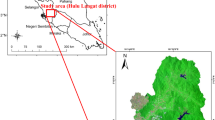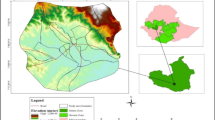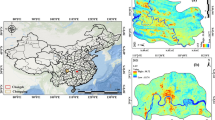Abstract
Urban heat island (UHI) is one of the important effects of urbanization on built environment. Land surface temperature data was taken from moderate-resolution imaging spectroradiometer (MODIS) to investigate the long-term spatiotemporal patterns of UHI in Wuhan during 2001~2018 and, the UHI intensity changes of built-up land in 13 administrative regions in Wuhan were analyzed. Furthermore, 34 spatial error models and 34 ordinary least squares models were established and compared. Spatial error models showed good fitting effect, which were used to determine the influence of normalized difference vegetation index (NDVI), normalized difference building index (NDBI), and social–economic factors (population and nighttime light) on UHI intensity in central urban area and new urban area. The explanatory power changes of these four indicators during 2001~2018 were explored as well. The average UHI intensity in 2014~2018 has increased by about 0.45 °C compared to that in 2001~2005. NDBI is the most dominant factor contributing to the increase in temperature. The impact of NDVI on UHI intensity changes from negative to positive, and the impact of NDBI on UHI intensity in central urban area is weakened during 2001–2018. Social–economic factors have a greater impact on new urban area than on central urban area. These findings show the effects and the explanatory power changes of driving factors during 18 years, which can provide a better understanding of the formation and development of UHI and support for the future urban planning of Wuhan.






Similar content being viewed by others
Data availability
The data and materials that support the findings of this study are available from the corresponding author upon reasonable request.
References
Anselin L (1995) Local indicators of spatial association—LISA. Geogr Anal 27:93–115. https://doi.org/10.1111/j.1538-4632.1995.tb00338.x
Boegh E, Soegaard H, Hanan N et al (1999) A remote sensing study of the NDVI-T(s) relationship and the transpiration from sparse vegetation in the sahel based on high-resolution satellite data. Remote Sens Environ 69:224–240. https://doi.org/10.1016/S0034-4257(99)00025-5
Bottyán Z, Unger J (2003) A multiple linear statistical model for estimating the mean maximum urban heat island. Theor Appl Climatol 75:233–243. https://doi.org/10.1007/s00704-003-0735-7
Carlson TN, Gillies RR, Perry EM (1994) A method to make use of thermal infrared temperature and NDVI measurements to infer surface soil water content and fractional vegetation cover. Remote Sens Rev 9:161–173. https://doi.org/10.1080/02757259409532220
Chen Z, Yu B, Yang C et al (2021) An extended time series (2000-2018) of global NPP-VIIRS-like nighttime light data from a cross-sensor calibration. Earth Syst Sci Data 13:889–906. https://doi.org/10.5194/essd-13-889-2021
Cui Y, Xu X, Dong J, Qin Y (2016) Influence of urbanization factors on surface urban heat island intensity: a comparison of countries at different developmental phases. Sustainability 8:706. https://doi.org/10.3390/su8080706
Dirksen M, Ronda RJ, Theeuwes NE, Pagani GA (2019) Sky view factor calculations and its application in urban heat island studies. Urban Clim 30:100498. https://doi.org/10.1016/j.uclim.2019.100498
Feng Y, Gao C, Tong X et al (2019) Spatial patterns of land surface temperature and their influencing factors: a case study in Suzhou. China. Remote Sens 11:182. https://doi.org/10.3390/rs11020182
Goward SN, Xue Y, Czajkowski KP (2002) Evaluating land surface moisture conditions from the remotely sensed temperature/vegetation index measurements: an exploration with the simplified simple biosphere model. Remote Sens Environ 79:225–242. https://doi.org/10.1016/S0034-4257(01)00275-9
Grigoraș G, Urițescu B (2019) Land use/land cover changes dynamics and their effects on surface urban heat island in Bucharest, Romania. Int J Appl Earth Obs Geoinf 80:115–126. https://doi.org/10.1016/j.jag.2019.03.009
Guha S, Govil H, Diwan P (2019) Analytical study of seasonal variability in land surface temperature with normalized difference vegetation index, normalized difference water index, normalized difference built-up index, and normalized multiband drought index. J Appl Remote Sens 13:1. https://doi.org/10.1117/1.jrs.13.024518
Gui X, Wang L, Yao R et al (2019) Investigating the urbanization process and its impact on vegetation change and urban heat island in Wuhan, China. Environ Sci Pollut Res 26:30808–30825. https://doi.org/10.1007/s11356-019-06273-w
Guo A, Yang J, **ao X et al (2020a) Influences of urban spatial form on urban heat island effects at the community level in China. Sustain Cities Soc 53:101972. https://doi.org/10.1016/j.scs.2019.101972
Guo J, Han G, **e Y et al (2020b) Exploring the relationships between urban spatial form factors and land surface temperature in mountainous area: a case study in Chongqing city. China. Sustain Cities Soc 61:102286. https://doi.org/10.1016/j.scs.2020.102286
Haase D, Nuissl H (2007) Does urban sprawl drive changes in the water balance and policy?. The case of Leipzig (Germany) 1870-2003. Landsc Urban Plan 80:1–13. https://doi.org/10.1016/j.landurbplan.2006.03.011
Hao Y, Zheng S, Zhao M et al (2020) Reexamining the relationships among urbanization, industrial structure, and environmental pollution in China—new evidence using the dynamic threshold panel model. Energy Reports 6:28–39. https://doi.org/10.1016/j.egyr.2019.11.029
Hu Y, Hou M, Jia G et al (2019) Comparison of surface and canopy urban heat islands within megacities of eastern China. ISPRS J Photogramm Remote Sens 156:160–168. https://doi.org/10.1016/J.ISPRSJPRS.2019.08.012
Huang X, Wang Y (2019) Investigating the effects of 3D urban morphology on the surface urban heat island effect in urban functional zones by using high-resolution remote sensing data: a case study of Wuhan, Central China. ISPRS J Photogramm Remote Sens 152:119–131. https://doi.org/10.1016/j.isprsjprs.2019.04.010
Hughes AC (2017) Understanding the drivers of Southeast Asian biodiversity loss. Ecosphere 8:e01624. https://doi.org/10.1002/ecs2.1624
Jiang L, Young MH, Hardee K (2008) Population,urbanization and the environment. World Watch, pp 34–39
Karakuş CB (2019) The impact of land use/land cover (LULC) changes on land surface temperature in Sivas city center and its surroundings and assessment of urban heat island. Asia-Pacific J Atmos Sci 55:669–684. https://doi.org/10.1007/s13143-019-00109-w
Keeratikasikorn C, Bonafoni S (2018) Urban heat island analysis over the land use zoning plan of Bangkok by means of Landsat 8 imagery. Remote Sens 10:440. https://doi.org/10.3390/rs10030440
Khamchiangta D, Dhakal S (2020) Time series analysis of land use and land cover changes related to urban heat island intensity: case of Bangkok Metropolitan Area in Thailand. J Urban Manag 9:383–395. https://doi.org/10.1016/j.jum.2020.09.001
Kim JH, Gu D, Sohn W et al (2016) Neighborhood landscape spatial patterns and land surface temperature: an empirical study on single-family residential areas in Austin, Texas. Int J Environ Res Public Health 13:880. https://doi.org/10.3390/ijerph13090880
Li H, Harvey JT, Holland TJ, Kayhanian M (2013a) The use of reflective and permeable pavements as a potential practice for heat island mitigation and stormwater management. Environ Res Lett 8:015023. https://doi.org/10.1088/1748-9326/8/1/015023
Li X, Zhou W, Ouyang Z (2013b) Relationship between land surface temperature and spatial pattern of greenspace: what are the effects of spatial resolution? Landsc Urban Plan 114:1–8. https://doi.org/10.1016/j.landurbplan.2013.02.005
Li Y, Sun Y, Li J, Gao C (2020) Socioeconomic drivers of urban heat island effect: empirical evidence from major Chinese cities. Sustain Cities Soc 63:102425. https://doi.org/10.1016/j.scs.2020.102425
Li YY, Zhang H, Kainz W (2012) Monitoring patterns of urban heat islands of the fast-growing Shanghai metropolis, China: using time-series of Landsat TM/ETM+ data. Int J Appl Earth Obs Geoinf 19:127–138. https://doi.org/10.1016/j.jag.2012.05.001
Lin Y, Jim CY, Deng J, Wang Z (2018) Urbanization effect on spatiotemporal thermal patterns and changes in Hangzhou (China). Build Environ 145:166–176. https://doi.org/10.1016/j.buildenv.2018.09.020
Liu G, Zhang Q, Li G, Doronzo DM (2016) Response of land cover types to land surface temperature derived from Landsat-5 TM in Nan**g Metropolitan Region, China. Environ Earth Sci 75:1–12. https://doi.org/10.1007/s12665-016-6202-4
Liu H, He X, Bai Y et al (2021a) Nightlight as a proxy of economic indicators: fine-grained GDP inference around mainland China via attention-augmented CNN from daytime satellite imagery. Remote Sens 13:2067. https://doi.org/10.3390/rs13112067
Liu H, Huang B, Zhan Q et al (2021b) The influence of urban form on surface urban heat island and its planning implications: evidence from 1288 urban clusters in China. Sustain Cities Soc 71:102987. https://doi.org/10.1016/j.scs.2021.102987
Lu Y, Yue W, Huang Y (2021a) Effects of land use on land surface temperature: a case study of Wuhan, China. Int J Environ Res Public Health 18. https://doi.org/10.3390/ijerph18199987
Lu Y, Yue W, Liu Y, Huang Y (2021b) Investigating the spatiotemporal non-stationary relationships between urban spatial form and land surface temperature: a case study of Wuhan. China. Sustain Cities Soc 72:103070. https://doi.org/10.1016/j.scs.2021.103070
Ma T, Zhou C, Pei T et al (2012) Quantitative estimation of urbanization dynamics using time series of DMSP/OLS nighttime light data: a comparative case study from China’s cities. Remote Sens Environ 124:99–107. https://doi.org/10.1016/j.rse.2012.04.018
Macintyre HL, Heaviside C (2019) Potential benefits of cool roofs in reducing heat-related mortality during heatwaves in a European city. Environ Int 127:430–441. https://doi.org/10.1016/j.envint.2019.02.065
Mackey CW, Lee X, Smith RB (2012) Remotely sensing the cooling effects of city scale efforts to reduce urban heat island. Build Environ 49:348–358. https://doi.org/10.1016/j.buildenv.2011.08.004
Monteiro FF, Gonçalves WA, de MB AL et al (2021) Assessment of urban heat islands in Brazil based on MODIS remote sensing data. Urban Clim 35:100726. https://doi.org/10.1016/j.uclim.2020.100726
Morabito M, Crisci A, Messeri A et al (2016) The impact of built-up surfaces on land surface temperatures in Italian urban areas. Sci Total Environ 551–552:317–326. https://doi.org/10.1016/j.scitotenv.2016.02.029
Morris CJG, Simmonds I (2001) Quantification of the influence of wind and cloud on the nocturnal urban heat island of a large city. J Appl Meteorol 40:169–182
NASA/METI/AIST/Japan Spacesystems and U.S./Japan ASTER Science Team (2019) ASTER global digital elevation model V003 [data set]. NASA EOSDIS Land Processes DAAC. https://doi.org/10.5067/ASTER/ASTGTM.003
Pathak C, Chandra S, Maurya G et al (2021) The effects of land indices on thermal state in surface urban heat island formation: a case study on Agra City in India using remote sensing data (1992–2019). Earth Syst Environ 5:135–154. https://doi.org/10.1007/s41748-020-00172-8
Peng J, Qiao R, Liu Y et al (2020) A wavelet coherence approach to prioritizing influencing factors of land surface temperature and associated research scales. Remote Sens Environ 246:111866. https://doi.org/10.1016/j.rse.2020.111866
Pichierri M, Bonafoni S, Biondi R (2012) Satellite air temperature estimation for monitoring the canopy layer heat island of Milan. Remote Sens Environ 127:130–138. https://doi.org/10.1016/J.RSE.2012.08.025
Qiu GY, Zou Z, Li X et al (2017) Experimental studies on the effects of green space and evapotranspiration on urban heat island in a subtropical megacity in China. Habitat Int 68:30–42. https://doi.org/10.1016/j.habitatint.2017.07.009
Shen H, Huang L, Zhang L et al (2016) Long-term and fine-scale satellite monitoring of the urban heat island effect by the fusion of multi-temporal and multi-sensor remote sensed data: a 26-year case study of the city of Wuhan in China. Remote Sens Environ 172:109–125. https://doi.org/10.1016/j.rse.2015.11.005
Shi W, Hou J, Shen X, **ang R (2022) Exploring the spatio-temporal characteristics of urban thermal environment during hot summer days: a case study of Wuhan. China. Remote Sens 14. https://doi.org/10.3390/rs14236084
Sun Y, Wang S, Wang Y (2020) Estimating local-scale urban heat island intensity using nighttime light satellite imageries. Sustain Cities Soc 57:102125. https://doi.org/10.1016/j.scs.2020.102125
Taylor J, Wilkinson P, Davies M et al (2015) Map** the effects of urban heat island, housing, and age on excess heat-related mortality in London. Urban Clim 14:517–528. https://doi.org/10.1016/j.uclim.2015.08.001
Taylor JR (2015) The China dream is an urban dream: assessing the CPC’s national new-type urbanization plan. J Chinese Polit Sci 20:107–120. https://doi.org/10.1007/s11366-015-9341-7
Tobler WR (1970) A computer movie simulating urban growth in the Detroit region. Econ Geogr 46:234. https://doi.org/10.2307/143141
van Heerwaarden CC, de Arellano JVG (2008) Relative humidity as an indicator for cloud formation over heterogeneous land surfaces. J Atmos Sci 65:3263–3277. https://doi.org/10.1175/2008JAS2591.1
Wan Z (2008) New refinements and validation of the MODIS land-surface temperature/emissivity products. Remote Sens Environ 112:59–74. https://doi.org/10.1016/j.rse.2006.06.026
Wang L, Hou H, Weng J (2020) Ordinary least squares modelling of urban heat island intensity based on landscape composition and configuration: a comparative study among three megacities along the Yangtze River. Sustain Cities Soc 62:102381. https://doi.org/10.1016/j.scs.2020.102381
Wang WC, Chang YJ, Wang HC (2019) An application of the spatial autocorrelation method on the change of real estate prices in Taitung city. ISPRS Int J Geo-Information 8:249. https://doi.org/10.3390/ijgi8060249
Wu W, Li L, Li C (2021) Seasonal variation in the effects of urban environmental factors on land surface temperature in a winter city. J Clean Prod 299:126897. https://doi.org/10.1016/j.jclepro.2021.126897
Xu H (2006) Modification of normalised difference water index (NDWI) to enhance open water features in remotely sensed imagery. Int J Remote Sens 27:3025–3033. https://doi.org/10.1080/01431160600589179
Yang Q, Huang X, Tang Q (2019) The footprint of urban heat island effect in 302 Chinese cities: temporal trends and associated factors. Sci Total Environ 655:652–662. https://doi.org/10.1016/j.scitotenv.2018.11.171
Yang X, Peng LLH, Jiang Z et al (2020) Impact of urban heat island on energy demand in buildings: local climate zones in Nan**g. Appl Energy 260:114279. https://doi.org/10.1016/j.apenergy.2019.114279
Yi K, Tani H, Li Q et al (2014) Map** and evaluating the urbanization process in Northeast China using DMSP/OLS nighttime light data. Sensors 14:3207–3226. https://doi.org/10.3390/s140203207
Yin C, Yuan M, Lu Y et al (2018) Effects of urban form on the urban heat island effect based on spatial regression model. Sci Total Environ 634:696–704. https://doi.org/10.1016/j.scitotenv.2018.03.350
Yu X, Liu Y, Zhang Z, **ao R (2021) Influences of buildings on urban heat island based on 3D landscape metrics: an investigation of China’s 30 megacities at micro grid-cell scale and macro city scale. Landsc Ecol 1–20. https://doi.org/10.1007/s10980-021-01275-x
Yu Z, Yao Y, Yang G et al (2019) Spatiotemporal patterns and characteristics of remotely sensed region heat islands during the rapid urbanization (1995–2015) of Southern China. Sci Total Environ 674:242–254. https://doi.org/10.1016/j.scitotenv.2019.04.088
Yue W, Liu X, Zhou Y, Liu Y (2019) Impacts of urban configuration on urban heat island: an empirical study in China mega-cities. Sci Total Environ 671:1036–1046. https://doi.org/10.1016/j.scitotenv.2019.03.421
Zhang L (2008) Conceptualizing China’s urbanization under reforms. Habitat Int 32:452–470. https://doi.org/10.1016/j.habitatint.2008.01.001
Zhang Y, Feng R, Wu R et al (2017) Global climate change: impact of heat waves under different definitions on daily mortality in Wuhan. China. Glob Heal Res Policy 2:10. https://doi.org/10.1186/s41256-017-0030-2
Zhang Y, Li C, Feng R et al (2016) The short-term effect of ambient temperature on mortality in Wuhan, China: a time-series study using a distributed lag non-linear model. Int J Environ Res Public Health 13:1–13. https://doi.org/10.3390/ijerph13070722
Zhang Y, Sun L (2019) Spatial-temporal impacts of urban land use land cover on land surface temperature: case studies of two Canadian urban areas. Int J Appl Earth Obs Geoinf 75:171–181. https://doi.org/10.1016/j.jag.2018.10.005
Zhou D, **ao J, Bonafoni S et al (2018) Satellite remote sensing of surface urban heat islands: progress, challenges, and perspectives. Remote Sens 11:48. https://doi.org/10.3390/rs11010048
Zhou X, Chen H (2018) Impact of urbanization-related land use land cover changes and urban morphology changes on the urban heat island phenomenon. Sci Total Environ 635:1467–1476. https://doi.org/10.1016/j.scitotenv.2018.04.091
Funding
All the authors thank the financial support from the National Natural Science Foundation of China (No. 52208110), National Key R&D Program of China (no. 2021YFE0113500), Key R&D Program of Hubei Province (2022BAA028), the Fundamental Research Funds for the Central Universities, China (grant number: 2020kfyXJJS097), and Research Project of the Ministry of Housing and Urban-Rural Development of China “Research and Demonstration of Optimal Configuration of Energy Storage System in Nearly Zero Energy Communities”(K20210466), Research of Low carbon and zero carbon building design methodology and key technology of CABR (No. 20220109330730005).
Author information
Authors and Affiliations
Contributions
All authors contributed to the study conception and design. Material preparation, data collection, and analysis were performed by **e Chen, Shicong Zhang, Zhiyong Tian, Yongqiang Luo, Jie Deng, and Jianhua Fan. The first draft of the manuscript was written by **e Chen, and all authors commented on previous versions of the manuscript. All authors read and approved the final manuscript.
Corresponding author
Ethics declarations
Competing interests
The authors declare no competing interests.
Additional information
Responsible Editor: Philippe Garrigues
Publisher’s note
Springer Nature remains neutral with regard to jurisdictional claims in published maps and institutional affiliations.
Rights and permissions
Springer Nature or its licensor (e.g. a society or other partner) holds exclusive rights to this article under a publishing agreement with the author(s) or other rightsholder(s); author self-archiving of the accepted manuscript version of this article is solely governed by the terms of such publishing agreement and applicable law.
About this article
Cite this article
Chen, X., Zhang, S., Tian, Z. et al. Differences in urban heat island and its driving factors between central and new urban areas of Wuhan, China. Environ Sci Pollut Res 30, 58362–58377 (2023). https://doi.org/10.1007/s11356-023-26673-3
Received:
Accepted:
Published:
Issue Date:
DOI: https://doi.org/10.1007/s11356-023-26673-3




